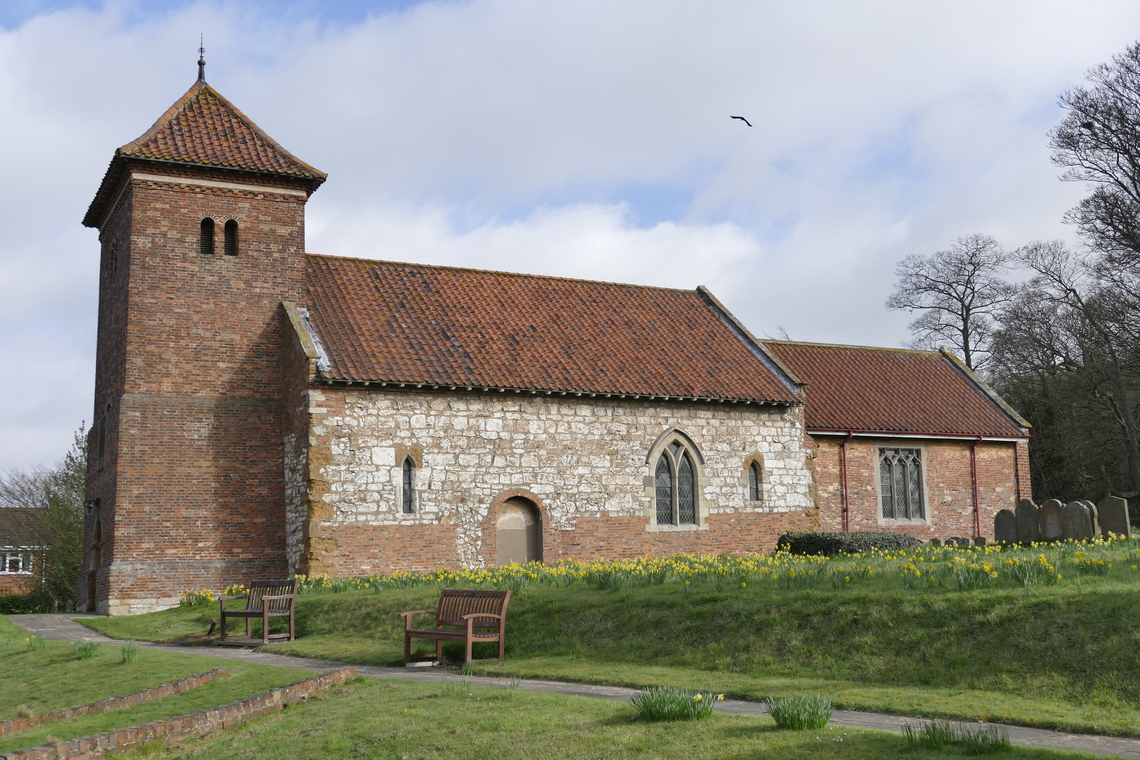The church you see today is a result of many renovations and changes since its building in the 12th century. There is no hint of an earlier church in the stone, ceramics and wood of the current building, though there may have been one.
In its life, the church has gone through several periods of poor maintenance when extensive renovations have been necessary. Hence, the wonderful quirks and mishmash of styles and new and reused materials etc.
The north wall
Three arches are visible, filled with 15th century windows and a blocked doorway. This is probably when the north aisle was removed. You can see the shaved capital edges of the columns where the arch markers meet indicating this wall is comparatively thin. Note the pieces of golden sandstone amongst the white chalk/limestone. These are probably reused
cornerstones (quoins) from the arcade. There is a piece of sandstone in the wonky buttress on the north-west wall. The boiler room was installed in the 1900’s and the vestry added during the 1818 restoration.
The west wall and tower
The steeple was restored/rebuilt in the early 18th century. It was completed by the time the two new bells were installed around 1724.The walls on either side of the tower are quite different. Squint, and you can see where the two lancet windows of the gallery were. The south side of the wall retains its sandstone quoins with fossils eroding out. The west wall
has levelling layers of reused medieval tile and early bricks. Some later bricks may have been made in Bonby’s own brick pit.
The South Wall
The nave is the most original and the chancel is more modern. The doorway, blocked up in 1818, had a porch as shown in a C. Nattes drawing. There are two lancet windows both in stained glass. One depicting St Andrew and the other St John the Baptist, these were installed in the 19th Century.
The East Wall
The 19th century saw two major restorations. One in 1818 and the second in 1894. There are floor plans for both restorations in Lambeth Palace Archives. The latter date is when the window in the east end was replaced with the one you see today. A piece of Y tracery from the old, eroded window, remains. It was found at the south-east corner. The window was replaced in 1894 In 2002, the rendering was stripped to fix the damp course revealing the stonework beneath.
The Tower
Today’s entrance to the church is through a recently refurbished door in the tower. On your left is the new kitchen, the stairs to the bell ringing floor are on the right.There is no public access to the ringing floor, but the wall is clad with panelling that has probably been reused from the box pews when they were removed during the 19th century.The area of the new kitchen was originally the stairs to the gallery and then a coal store. The front door and lychgate were restored in 2023.
The Bells
There are three bells in the tower.
The treble (Bell No 1) is dated to C1450 and has a diameter of 26" and believed to have been made at the Bell Foundry of John Hoton.
Bell No 2 is dated to 1724 and has a diameter a little over 30" and believed to have been made at the Bell Foundry of Daniel Hedderly.
The Tenor (Bell No 3) is dated to 1724 and has a diameter a little over 33" and is also believed to have been made at the Bell Foundry of Daniel Hedderly.
Notes
Bell 1 - D.
Bell 2 - C#
Bell 3 - B
The bells hang in an Oak frame which probably dates to the 1720s and consequently the bells may no longer be rung full circle, however the Bonby Bell ringers regularly put on a musical feast for the ears chiming the bells weekly at practices and once a month for the monthly Communion Church Service as well as at special occasions (Christmas/Easter/Weddings/Funerals etc).




